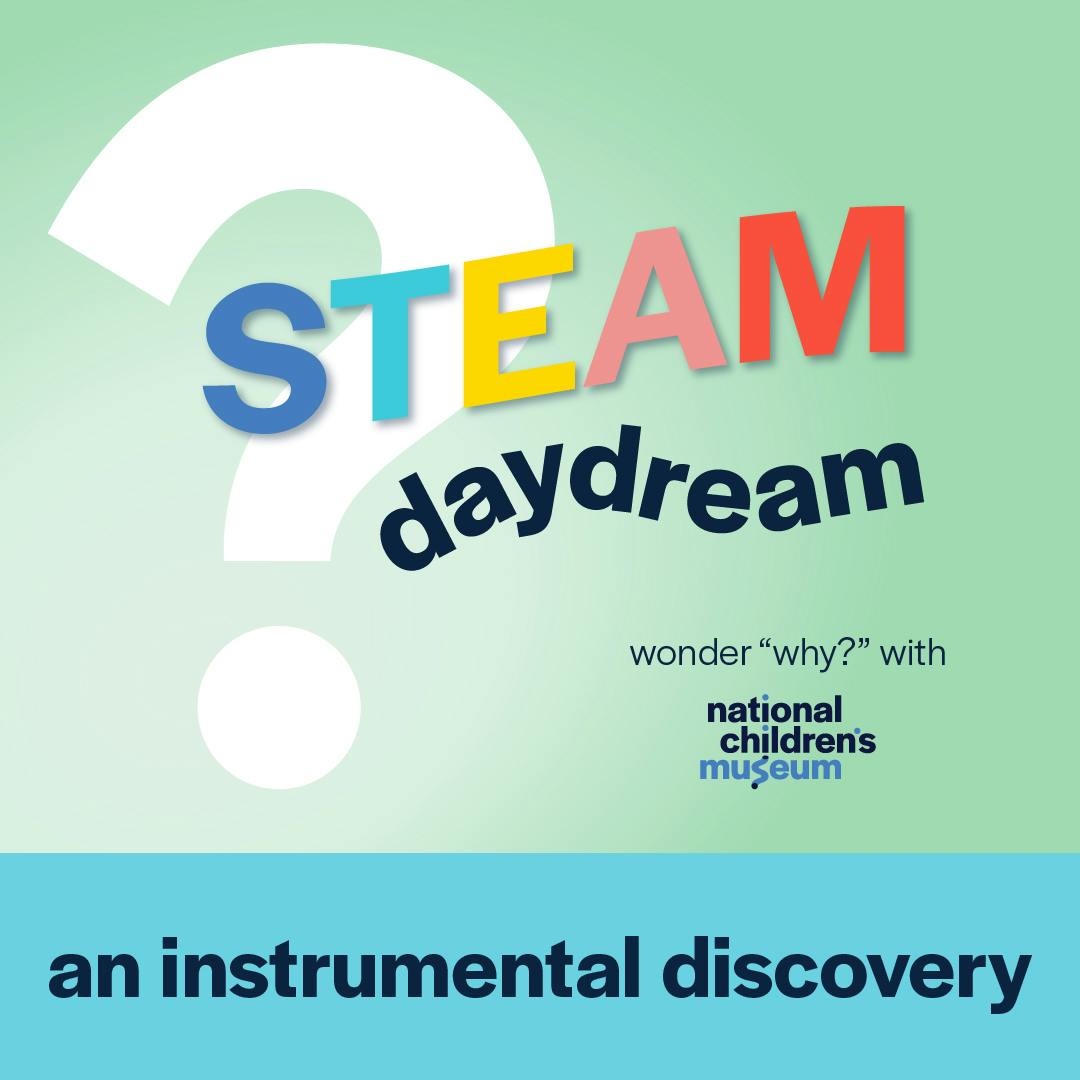an instrumental discovery
Aubrey and Andre are on a mission to find a theme song for A.J.’s barking cat, Newton, but they can’t find a track that strikes the right chord. They decide to make it themselves with the help of 10-year-old Kid Investigator Exum. They stumble upon a set of plastic tubes, each of which makes a beautiful sound when struck with a mallet—but how?
 meet our kid investigator Exum L. (he/him) from Washington, DC 10-years-old favorite school subject: science and math |
 meet our expert Stephon Alexander (he/him) Professor of Physics at Brown University fun fact: "Waves and vibration are a big part of sound and the way the universe works.” |
- matter: anything that has mass and takes up space
- atoms: the smallest unit of matter
- energy: the ability to do work
- sound waves: a pattern caused by energy that carries sound from an origin (like an instrument) through a medium (like air or water) to your ear
- frequency: the rate at which something occurs in a particular period of time; in sound, the number of sound waves produced in one second
- vibrate: to move back and forth rapidly
- wavelength: the distance between the peaks of two consecutive waves
- pitch: the degree of highness or lowness of a tone governed by a sound wave’s frequency
- 1-PS4-4 Waves and Their Applications in Technologies for Information Transfer: Plan and conduct investigations to provide evidence that vibrating materials can make sound and that sound can make materials vibrate.
- 1-PS4-4 Waves and Their Applications in Technologies for Information Transfer: Use tools and materials to design and build a device that uses light or sound to solve the problem of communicating over a distance.
- 4-PS3-2 Energy: Make observations to provide evidence that energy can be transferred from place to place by sound, light, heat, and electric currents.
A.J.: All right, let’s see here…. Water. Check! Sleeping bag. Check! Bear spray. Check. Hiking boots. Check! Ok, that’s everything. Finally, time to relax and be one with nature. Last step—turning off this phone.
[RINGTONE]
A.J.: Huh? Not again.. Hello—
AUBREY: A.J.! A.J! Are you there?
A.J.: If by “there” you mean my remote, secluded, and peaceful campsite, then no not yet. But I’m pulling out of the driveway as we speak.
ANDRE: Wait! Can you stop by the studio first?
AUBREY: It’s an emergency!
A.J.: Ok, I’ll be there in a few minutes.
[FAST MUSIC]
AUBREY: Ok, way too fast. Where’s the suspense? Next!
[SLOW MUSIC]
ANDRE: Are those—whale sounds? Definitely not. Next!
[DANCE MUSIC]
AUBREY: No, no, no, no, no!
A.J.: Hey, what’s going on? I got here as fast as I could.
AUBREY: We can’t find it!
A.J.: Find what?
AUBREY: Newton’s theme song!
[MEOW/BARK]
AUBREY: We thought since we have a theme song, Newton should have one too.
A.J.: Wait…we have a…theme song?
ANDRE: Yeah? Haven’t you ever noticed the music that plays every time you introduce the show? Try it!
A.J.: Ok let’s see…
[MUSIC]
A.J.: You’re listening to STEAM Daydream with… Weird. Ok, ok, I got it!
[MUSIC]
A.J.: You’re listening to STEAM Daydream with… Okay, one last time, here it goes…
[MUSIC]
A.J.: You’re listening to STEAM Daydream with National Children’s Museum, where we solve the world’s many STEAM mysteries one episode at a time: we’ll observe, we’ll ask questions, we’ll investigate, we’ll research, and then we’ll connect the dots! Hmm… I can’t believe I never noticed that….
ANDRE: Pretty cool, right?
AUBREY: We’ve been looking through songs all morning, but we can’t find the right one for Newton.
A.J.: Well, if you know what you’re looking for—or listening for, I should say—why don’t you just make it yourself? You can use the instruments we have at National Children’s Museum!
AUBREY: Of course, why didn’t I think of that?! Time to rock n’ roll!
A.J.: Uh, I have to hit the road, but I’ll ask Exum, our 10-year-old Kid Investigator from DC, to meet you at the Museum. He’ll be happy to help!
[MUSIC]
AUBREY: Hi Caitlin!
CAITLIN: Hey there! What brings you to the Museum today?
ANDRE: A.J. said we have some instruments here that we could use.
CAITLIN: Of course! Head downstairs, make a left at the slide, a right at the batting cage, and then a quick U-turn before you get to Data Science Alley and you’ll see them! What are you up to? Starting a band or something?
ANDRE: Sort of! We’re making a theme song for A.J.’s barking cat, Newton!
CAITLIN: No way! What’s it going to sound like?
AUBREY: We haven’t exactly figured that out yet. We’re hoping the musical instruments will inspire us.
CAITLIN: You should talk to some of the Museum visitors today. They always have fun ideas—maybe they’ll have some tips for you!
AUBREY: Good thinking! We’ll talk to a few on our way to find the instruments. Thanks, Caitlin!
[MUSIC]
FACILITATOR: Can you introduce yourself to me? So, your name, how old you are, and then where you live.
CHILD 1: Hi my name is Nia, I’m ten years old and I live in Germantown.
CHILD 2: I’m Kurlov, I live in New Jersey, I’m eight years old.
CHILD 3: My name is Lulu. I'm six years old and I live in New Jersey.
CHILD 4: My name is Ishal and I’m ten years old and I’m from Massachusetts.
FACILITATOR: Do you know what a theme song is?
CHILD 2: Bluey! [hums Bluey theme song]
CHILD 3: Paw Patrol, Paw Patrol, we’ll be there on the double, Paw Patrol, Paw Patrol—um I forgot the rest!
CHILD 4: [humming We Don’t Talk About Bruno] We don’t talk about Bruno no no no no! We don’t talk about Bruno!
FACILITATOR: So I know this cat named Newton—kind of silly—he barks. If you were making a cat theme song, what would it sound like?
CHILD 1: It would sound like some beatboxing, like with hip hop music.
CHILD 3: It would sound like a cat meowing, meowing, meowing!
CHILD 4: Like it could be instruments, like it could be two objects together!
CHILD 2: No, it’s like an Avenger like— [hums tune]
AUBREY: Now, those are some good notes. And look, here are the instruments!
[MUSIC]
AUBREY: A harmonica!
ANDRE: Oh, a guitar!
EXUM: Hi! You must be Aubrey and Andre. I’m Exum—A.J. said I’d be able to find you by following the music—or really loud noises? Do either of you know how to actually play an instrument?
AUBREY: Not exactly. We thought we would just learn as we go.
EXUM: Hm, maybe we should stick to something a little more beginner friendly.
ANDRE: How about these tubes?
AUBREY: Why are those in here? Tubes aren’t instruments!
EXUM: I don’t know… It looks like they’re all made of a plastic material … and they’re all the same width—about as big around as a softball—with a hollow center.
ANDRE: I think they might be different lengths, though. Let’s sit them upright and see.
EXUM: Yeah, definitely different lengths.
AUBREY: So how are we supposed to use these as instruments?
EXUM: What if we hit them with this mallet?
ANDRE: Woah! Can I try?
ANDRE: Hmm.. Why do they each sound different?
AUBREY: I don’t know, but if we’re going to make Newton an awesome theme song we need to figure out what makes each tube sound different. Then we’ll know which one to hit for each note!
EXUM: Sounds like a STEAM mystery that needs solving! Let’s start with what. we. know. First, what is sound?
ANDRE: Sound is something we hear with our ears. Let’s close our eyes for a second and imagine we’re outside, somewhere. Anywhere!
AUBREY: Ok…
ANDRE: Where are we, Aubrey?
AUBREY: We’re on top of a mountain!
ANDRE: Aha, do you hear that? The birds are singing!
AUBREY: And that soft sound. That’s the wind rustling the leaves… Woah, what was that? An earthquake?!
ANDRE: Sorry, that was my stomach. I’m a little hungry. Anyways, you get the point. The world is full of sounds!
EXUM: But hold on. Andre, you said, “Sound is something we hear with our ears.” Do we know what that “something” in the sentence is? What exactly are we hearing?
AUBREY: I have an idea! Let’s call our friend Professor Stephon who teaches physics at Brown University. I bet he’ll be able to tell us what that “something” is.
[RINGTONE]
STEPHON: Hello, this is Professor Stephon Alexander.
AUBREY: Hey, it’s Andre and Aubrey. We’re here with our Kid Investigator Exum trying to solve a mystery about sound. Do you mind answering a few questions for us?
STEPHON: Of course! How can I help?
ANDRE: First off, can you explain what sound is and how it’s made?
STEPHON: Sound is something that you hear, something that your ears pick up. What creates a sound is an object, like your voice or an instrument, that is vibrating. And that vibration causes the air to vibrate. The air’s made up of particles. You can think of them as little balls, and they’re all next to each other. And imagine that one of those balls, if it goes up and down—and as it goes up and down, it hits the ball next to it, and the other one will go up and down. And every other particle starts moving like a slinky, and that movement of the neighboring air particles carry this wave—this up and down motion.
ANDRE: Oh, so the “something” we hear with our ears is actually a result of tiny vibrating particles.
AUBREY: So when a firework explodes in the air, the loud popping we hear is actually the sound of the surrounding air molecules vibrating back and forth?
STEPHON: That’s right!
EXUM: But how can we hear the noise from tiny particles vibrating if they’re so far away from our ears?
STEPHON: Another way of thinking about what this sound is—I want you to think about water waves. When you throw a rock, and it hits the water, it creates a wave, like ripples of water moving. And a sound wave is just like that, except it's not the water that's waving, but it's actually the air particles that are behaving like water waves. And those air waves are actually what we call sound waves.
ANDRE: Gotcha. So the sound created by the vibrating particles next to the source of the sound travels to our ears in the form of a wave.
EXUM: Yeah, that’s right! Eventually, the wave loses enough energy that it can no longer travel. At that point, our ears wouldn’t be able to pick up the sound anymore.
AUBREY: Ahh… So if a firework, which is the sound source, explodes a mile away from where we’re standing, the reason we can hear the pop from the explosion is because of the massive amount of energy that created the sound wave.
STEPHON: Exactly!
ANDRE: Wait a second… If all sounds are the result of particles vibrating, then why doesn’t everything sound the same?
STEPHON: If you want to think about how a sound wave moves, you have to think about how the wave goes up and down. The wave has to go up and down, up and down as it moves, but a sound wave can go up and down really really fast, and it can go up and down really really slow. And we call how fast a wave goes up and down its frequency. It's like how frequently it goes up and down. If the frequency is high, the sound wave goes up and down really fast. If the frequency is low, the sound wave goes up and down very slow. And sound waves that have a high pitch—that means the frequency is high, compared to a sound wave that is low pitch, low frequency. And we can hear that different sounds sound differently. We can hear that a flute sounds different from a piano. What creates the difference is actually you just don't have one wave an instrument will produce, they all get combined together—it’s like ingredients all coming together to make the flute sound like a flute, and a piano sound different. So it’s different ways that sound waves can come together that makes it sound different.
AUBREY: That makes sense! Thanks for your help, Professor Stephon.
STEPHON: All right, this was fun. Good luck solving your mystery!
EXUM: Ok, STEAM Daydream Team, I think we’re ready to connect the dots!
[MUSIC]
AUBREY: When we strike the mallet against one of the plastic tubes, the particles closest to the end we hit vibrate back and forth. Those vibrating particles bump into their neighbor particles, and make their neighbors vibrate too. Our ears then capture the movement of the vibrating particles, and translate them into what we hear as sound.
ANDRE: Because the plastic tubes are all made out of the same material and we’re striking them with the same mallet in the same way, our ears hear sounds that are very similar.
AUBREY: But they aren’t exactly the same… They’re different pitches!
EXUM: Remember, a sound wave’s wavelength and frequency are directly related to each other and to the pitch of the sound it carries.
AUBREY: When the wavelength is shorter, it's a higher frequency. When the wavelength is longer, it's a lower frequency.
ANDRE: Our ears translate sound waves with high frequencies into high-pitched sounds and sound waves with low frequencies into low pitched sounds.
EXUM: So, we know the tube that makes the highest pitched sound creates sound waves with the highest frequency, and the tube that makes the lowest pitched sound creates the sound waves with lowest frequency.
ANDRE: Which leaves us with one question: Why do the tubes create sound waves with different frequencies?
EXUM: I wonder if the different lengths of these tubes explain the different frequencies of the sound waves they form…
AUBREY: There’s only one way to find out! Let’s line up the tubes in order from tallest to shortest. There we go. Ok, Andre, give ‘em a whack!
[MUSIC]
AUBREY: Ah-ha! Just as we suspected!
ANDRE: The tallest tube made the lowest pitched sound and the shortest tube made the highest pitched sound! Which means we have the answer to today’s mystery!
EXUM: Different variables, like the size, shape, and length of an object, can affect the way an object vibrates. The reason the tubes make different sounds comes down to length. The different lengths of the tubes leads to a difference in the wavelength of the soundwaves they form!
[MUSIC]
AUBREY: Way to go team! Now let’s put our new knowledge to use and make Newton the best theme song ever.
ANDRE: Ready? 5, 6, 7, 8!!
[MUSIC]
A.J.: Well, there you have it! Sound is all about good vibrations. Next time you’re at National Children’s Museum, check out the Spotify Dance Party Pod located in our Entry Level Hallway to D.J. your own good vibrations. Queue up your favorite songs to dance along, and when you hit that high note, remember what makes it possible—high frequencies! That’s all for today’s episode, Dreamers! Pop by for our next episode to help us square why bubbles are always round. In the meantime, if you enjoyed today’s show, please leave a review to help other curious kids discover our podcast. Be sure to subscribe wherever you’re listening so you don’t miss out on our next adventure. You can find more STEAM programs and resources on our website at www.nationalchildrensmuseum.org. Season 2 of STEAM Daydream with National Children’s Museum is generously sponsored by GEICO. It’s narrated by me, A.J. Calbert, produced by Paige Childs, with sound design and engineering by Maddie Zampanti of Conceptual Podcasting. Take care, Dreamers!

